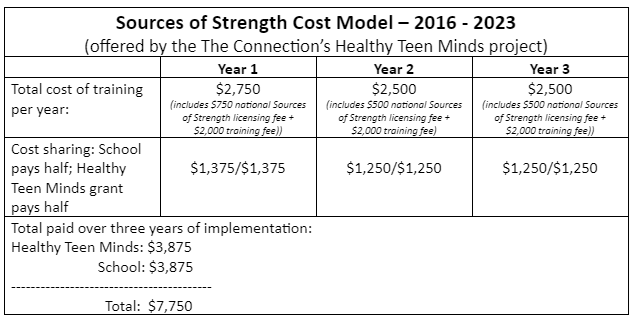Sources of Strength
Coalitions that Adopted
Strategy Type
School-basedStrategy Goal
Reduce the rate of depression among teens by implementing population-level strategies that focus on prevention, including promoting social-connectedness, resiliency and help-seeking behavior among youth; intervention for struggling teens; and improving access to care.Intended Population
Students and youth-serving staff in middle and high schools across Calumet, Outagamie, and Winnebago Counties.Strategy Background
In 2016, the Healthy Teen Minds initiative made the strategic decision to invest in a region-wide implementation of Sources of Strength, a best practice youth mental health promotion and suicide prevention program.
This project was informed by alarming youth mental health data and community concern over a growing youth mental health crisis. At the time, the community was reeling from a cluster of teen suicides in Kaukauna and several other unrelated teen suicides throughout the Fox Cities. 2015 data from the Youth Risk Behavior Survey (YRBS) across Calumet, Outagamie, and Winnebago Counties revealed that about one-fourth of local teens reported feeling “sad or hopeless” on the survey, which was used as a proxy for teen depression. Students in the region were also attempting suicide at a higher rate than the state and national averages.
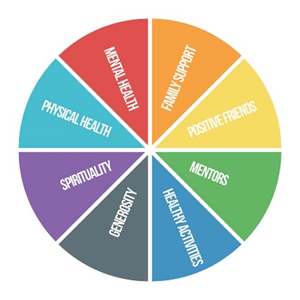 Sources of Strength uses an upstream approach to suicide prevention and moves beyond singular risk factors to focus on multiple sources of support. The program incorporates teams of Peer Leaders mentored by Adult Advisors to change social norms and encourage students to individually assess and develop strengths in their lives. Sources of Strength is rooted in eight "strengths" – research-backed support factors that protect against suicide risk. The strengths include family support, positive friends, mentors, healthy activities, generosity, spirituality, physical and mental health.
Sources of Strength uses an upstream approach to suicide prevention and moves beyond singular risk factors to focus on multiple sources of support. The program incorporates teams of Peer Leaders mentored by Adult Advisors to change social norms and encourage students to individually assess and develop strengths in their lives. Sources of Strength is rooted in eight "strengths" – research-backed support factors that protect against suicide risk. The strengths include family support, positive friends, mentors, healthy activities, generosity, spirituality, physical and mental health.
Sources of Strength is radically positive and uses Peer Leaders to spread messages of “hope, help, and strength” that change school culture by growing help-seeking behavior, breaking down codes of silence around mental health struggles, and improving perceptions of adult support. The program involves strategically designed strength-based messaging campaigns developed by local peer teams to improve school culture and positively impact their peers throughout the school and community.
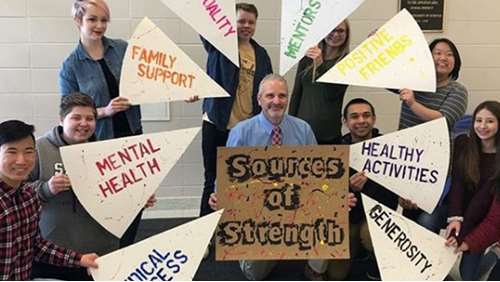 The Healthy Teen Minds team chose the Sources program as a means to improve the mental health of teens in the tri-county region, with the goal of implementing it at all local high schools, along with a middle school “pilot program” in three schools. The coalition used AHW funding to dramatically reduce the program’s cost by 75% for schools and create a regional trainer certification program, further reducing costs. Participating schools committed to three years of annual trainings. Ultimately, the coalition was able to successfully embed Sources of Strength in 22 local schools and certify 14 regional trainers to carry the program forward.
The Healthy Teen Minds team chose the Sources program as a means to improve the mental health of teens in the tri-county region, with the goal of implementing it at all local high schools, along with a middle school “pilot program” in three schools. The coalition used AHW funding to dramatically reduce the program’s cost by 75% for schools and create a regional trainer certification program, further reducing costs. Participating schools committed to three years of annual trainings. Ultimately, the coalition was able to successfully embed Sources of Strength in 22 local schools and certify 14 regional trainers to carry the program forward.
In addition to embedding the program in local middle and high schools, Healthy Teen Minds worked to ensure a sustainable model for Sources of Strength in the community. One of the coalition’s partners, ThedaCare, used Healthy Teen Minds’ business and training model to duplicate the project within their service area, which includes six adjacent counties to the north and west of the coalition’s footprint, leading to implementation in 12 additional high schools. Further, the coalition held conversations with the local Cooperative Educational Service Agency, CESA 6, to increase collaboration and discuss options for further program sustainability. After sending their own staff to the coalition’s training event, CESA 6 ultimately agreed to take over the program under their Allies in Mental Health Education (AMHE) initiative, creating a path for additional schools in the region to implement and sustain Sources of Strength for years to come.

Did you know: Sources of Strength is considered the first suicide prevention program to demonstrate effectiveness using peer leaders to enhance protective factors associated with reducing suicide in a school.
Strategy: Creating a Reduced Cost Model
Growing a region-wide implementation of Sources of Strength at middle schools and high schools in the requires several key steps. Though Sources is a very popular school-based mental health promotion program, its cost to implement and sustain is a barrier for many schools, particularly for small, rural districts with limited budgets. What helped make Healthy Teen Minds’ project successful was their ability to create a business model that dramatically reduced the cost for schools to implement the program by 75 percent through investing in the certification of regional trainers.
Twenty-two schools that joined the project committed to three years of consecutive trainings to allow the program to take hold, grow and positively influence school culture. Twelve school-based trainers were trained across eight schools.
Strategy: Localizing Trainers
Strategy: Creating a System for Evaluation
Challenges and Tactics to Address Them
List of Challenges & Tactics
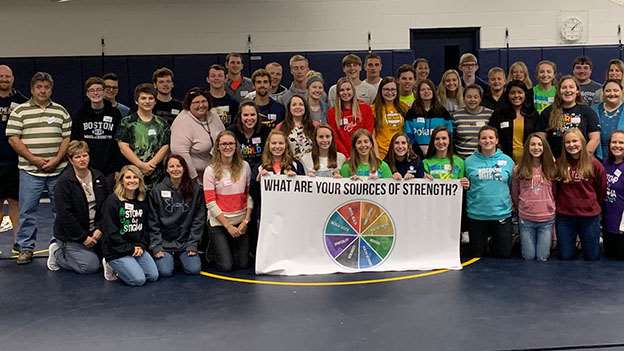
A testament to their success in sustaining the program, Health Teen Minds worked with CESA 6 to oversee implementation of Sources of Strength, ultimately folding it into its “Allies in Mental Health Education” (AMHE) program.
Best Practices
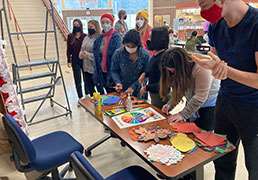
“When there is unilateral support throughout the school and everyone in the building is able to ‘speak the same language’ around Sources… the campaigns are more successful.”
Resources Needed
An understanding of the broad time and financial costs involved in embedding Sources of Strength in local schools can assist in planning and prevent unexpected delays or shortages that hinder progress. Adopting and implementing Sources of Strength can be a costly endeavor for a school, both in terms of money and staff time. The Healthy Teen Minds project made a large investment on the front end to certify two regional trainers. Additionally, the Project Coordinator, whose position was funded by the AHW grant, devoted two-thirds of her time toward the management and coordination of the Sources implementation project.




